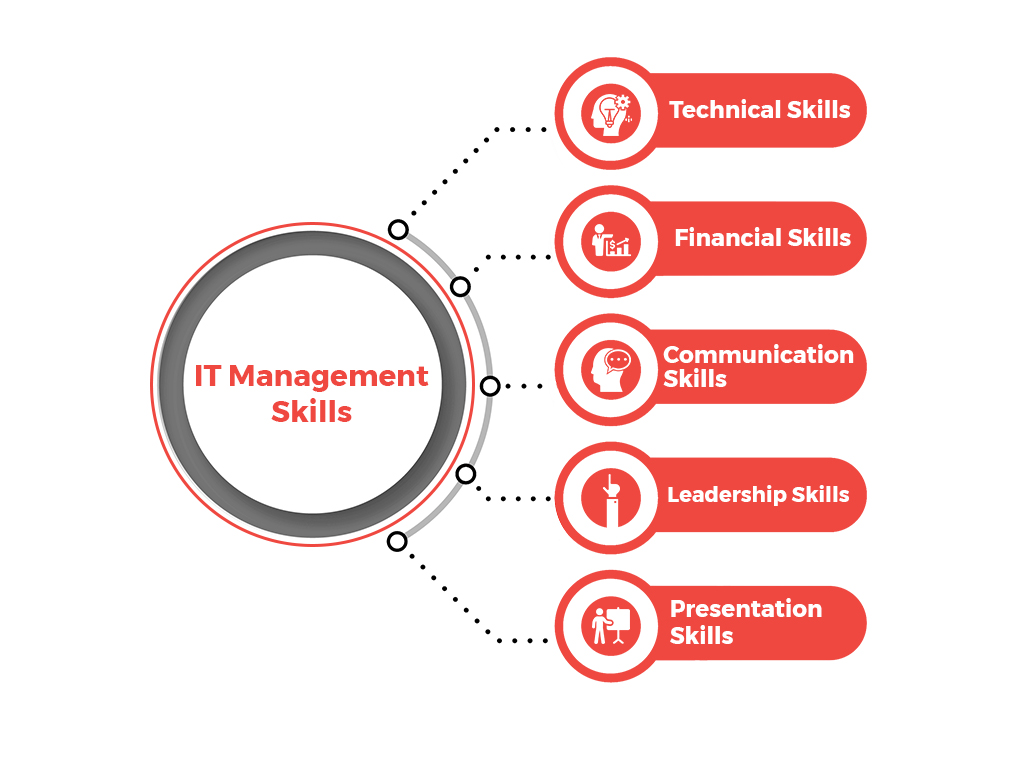IT management can be defined as the process of managing services related to technology. That can include managing hardware, networks, security systems, and staff/vendors, as well as determining which technologies to purchase and implement.
For business owners, IT management handles the IT infrastructure that controls most of your production, security, and competitive advantages. IT management is all about managing three components: First, there’s IT infrastructure, which involves making sure infrastructure operates properly. Second, there’s security, which ensures the system(s) are protected and that you’re complying with all security standards. Finally, there’s planning, which involves finding new technology that can help your business thrive and ensure you are getting the best return on your investment.
As a business owner, you can manage your infrastructure and planning either internally or by hiring a managed service provider. The key is that IT management can turn your technology from a necessary expense to an important asset, saving you money and mitigating IT risk.
Let’s explore its components, benefits, and implementation strategies.
Why is IT Management Important for Business?
According to Statista, over $4.6 billion was spent on IT solutions in 2023, and that number is expected to continue rising. So, if organizations are spending a lot on IT systems, they need a way to make sure those systems work well and are secure. That’s the main point of IT management, but there’s more:
It Enhances Productivity
With proper IT management, employees can access the tools they need to do their jobs. For example, these tools might provide technical support that helps people resolve issues promptly.
Also, IT management teams implement automation tools that reduce unnecessary workloads and fuel innovation.
When employees are productive, they give their best. In turn, customers get higher-quality products or services and are satisfied. And happy customers mean more profits for your business.
It Reduces Costs
The initial costs of setting up an IT infrastructure can discourage businesses, especially small ones, from investing. Add that to the costs of hiring IT staff, and you can see why there may be hesitation.
However, this initial investment is well worth it. IT management can help you save money by finding less expensive equipment from vendors without compromising safety and productivity. In addition, IT management teams can implement security protocols that prevent expensive cyber attacks.
It Helps Businesses Track Strategic Goals
You need a way to monitor your performance to ensure you are meeting your strategic goals. With IT management, you can do that. It has tools to help you track the systems and software being used in your organization. It can monitor subscriptions and licenses and renew them before they expire.
IT management can also track data and the people who have access to that information, ensuring it is secure and updated.
It Supports Growth
As youR business begins to scale, your existing IT systems may not have the capability to meet future demands. This is a problem you can solve by upgrading your infrastructure. With effective IT management, you can oversee this process and find the right resources with little to no disruption during the transition.
IT Management Creates Standardization
IT management creates uniformity within your organization’s IT systems, which improves efficiency. For example, it might define security protocols for addressing breaches or create a system for submitting service tickets. These guidelines can give employees clarity and protect your sensitive data.
IT Management Strategies in 2024
IT management strategies are always evolving. What worked pre-pandemic will no longer be effective. In the era of remote and hybrid work arrangements, your IT remains the backbone of your business.
So, what should your management strategy look like this year and beyond? Let’s discuss them below.
Focus on IT Governance and Leadership
The demands placed on enterprise IT continue to become more expansive and complex. As a result, IT governance is required to ensure these initiatives meet their individual goals and serve larger business objectives.
Over the years, several IT governance frameworks have been developed to make governance processes consistent. They include COBIT (control objectives for information and related technologies), NIST Cybersecurity Framework, ITIL (information technology and infrastructure library), and ISO/IEC 27001.
Some of these frameworks offer a comprehensive IT governance execution plan; the rest are for specific use cases.
More importantly, IT leaders must integrate their expertise and strategic vision to execute a technology strategy that contributes to the company’s long-term success.
Enhance Cybersecurity Measures
Cybercriminals will continue to devise new, sophisticated ways to launch attacks. Cybersecurity Ventures estimates that the global annual cost of cybercrime in 2024 will reach $9.5 million USD.
Cybersecurity isn’t just a nice-to-have; it is a must-have. Make it a part of your IT management strategy this year and beyond. This is especially important, as cloud computing is probably a significant portion of your workflow.
Cybersecurity is also important if you have employees working from remote locations. You want to extend all protections to individuals who have access to your systems and information.
A proper cybersecurity infrastructure can prevent data breaches and other attacks, as well as resolve issues quickly.
Optimize Cloud Infrastructure
Cloud computing has been around since the 1990s. However, the rise of remote work has increased its traction. This technology allows distributed teams to collaborate seamlessly and save costs.
According to Gartner, global end-user spending in 2023 alone reached $600 billion USD. So, you are leaving money on the table if cloud computing isn’t at the center of your IT management initiatives.
Gartner also reveals that 70% of enterprises will use industry cloud platforms (ICPs) to accelerate their business initiatives by 2027 — a significant increase on the less than 15% that used it in 2023. This tells you that many of your competitors will gradually invest in cloud infrastructure this year and beyond.
If you don’t want to remain competitive, you must also do the same.
Adopt Artificial Intelligence (AI) and Machine Learning
As you formulate your IT strategies for this year, consider integrating emerging technologies like AI and machine learning. These technologies can help you quickly resolve customer issues, fix bugs, enhance your security,, and much more.
For example, AI can help developers automate repeated tasks, such as code testing and identifying bugs. That way, they can focus on more complicated tasks. And this is only scratching the surface of what these new technologies can actually do.
As AI and machine learning become more sophisticated, more businesses will incorporate them into their operations.
Sustainable Technology Practices
Technologies such as cloud computing, IoT (Internet of Things), cryptocurrency, and AI are raising concerns about their related energy consumption and environmental impact.
According to Gartner, by 2027, 25% of chief information officers (CIOs) will link their personal compensation to their sustainable technology impact.
You don’t need to wait that long, Incorporate sustainable tech practices into your IT strategy this year. Adopt green technology practices, such as using energy-efficient hardware, optimizing data center usage, and promoting remote work. You will be saving our planet.
The Role of an IT Manager
An IT manager is an information technology professional who oversees all computer-based activities within a business. They coordinate tasks related to the hardware, software, and network that the business uses.
An IT manager may also manage and train a group of other IT specialists. Some of their responsibilities include:

- Managing a company’s computer systems
- Managing a company’s IT
- Overseeing system testing and other computer-related updates
- Maintaining a safe work environment by following security protocols
- Hiring and training IT employees
- Detecting problems within the system
- Assessing IT operations
Conclusion
IT management maximzes technological resources to improve productivity, efficacy, and overall business performances. Whether you are streamlining internal processes, enhancing cybersecurity, or taking advantage of data analytics, the importance of IT management cannot be overestimated.
However, having an effective IT management process begins with hiring the right IT manager.
At DistantJob, we know the importance of having talented techies. If you want to hire a manager, we can help you. Tell us about the candidate you’re looking for, and in 2 weeks, we will find the perfect match for you!





